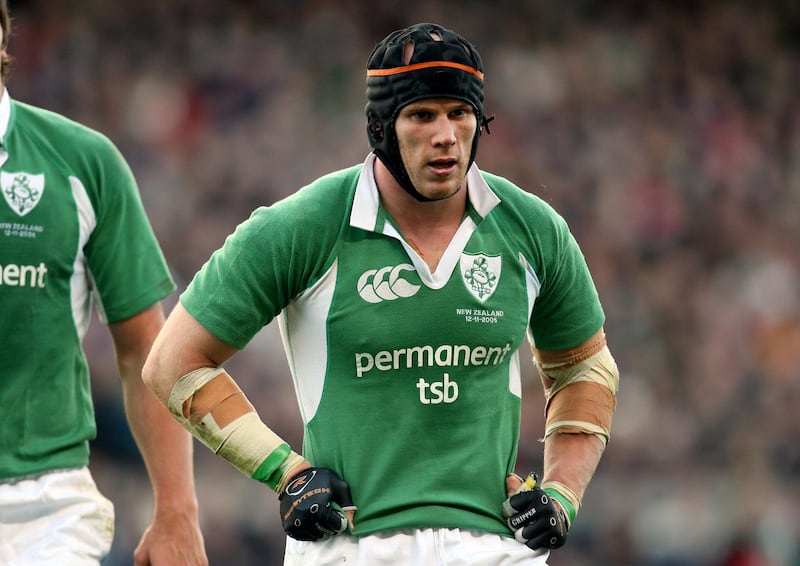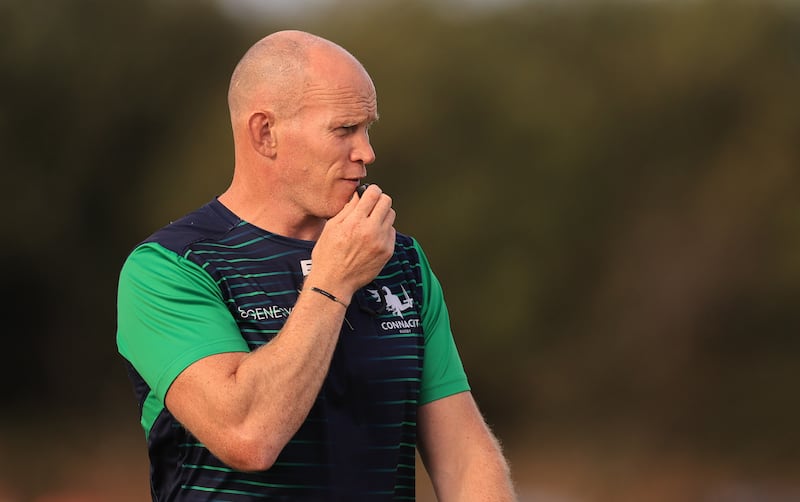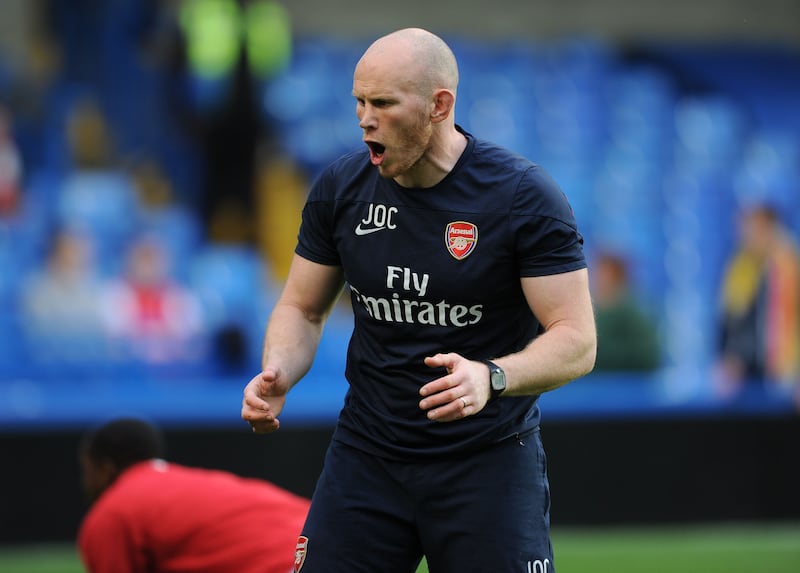Johnny O’Connor remembers his first day in the Arsenal academy.
Just a few weeks earlier his long and lionised and sometimes frazzled life as a professional rugby player had ended. He was 33 years old, launching head-first into a new career, in a different sport, in one of the biggest soccer clubs in Britain. In the gym, he was introduced to a 16-year-old boy who had landed from Barcelona. Two aliens.
“I was taking him for a gym session,” O’Connor says. “He had no English and I had no Spanish. We were both looking at each other. It was trial by fire. ‘Go in there, we’ll back you, you’ll figure it out’. Did I have any business going straight in there from where I had come from? Probably not. But I had enough work ethic to go in.”
Once he entered, Arsenal was his door to everywhere. They didn’t need to import anything from rugby. They needed somebody who was abreast of the science and could make connections with people. The interpersonal piece was the soul of their approach.
Kilkerrin-Clonberne see off Kilmacud to secure a fourth straight All-Ireland club title
The top 25 women’s sporting moments of the year: 25-6 revealed with Mona McSharry, Rachael Blackmore and relay team featuring
GAA previews: Goal-hungry Na Fianna bidding to book All-Ireland final place
Sarsfields still savouring the sweet taste of provincial success
![Johnny O'Connor: 'You find a group that you feel you’re connecting with. At this moment in time – I don’t know if they [Galway hurlers] feel the same – but I feel like I’m making a connection.' Photograph: James Crombie/Inpho](https://www.irishtimes.com/resizer/v2/6REQ6ISLYJHTFBNWNGW5MUWKKY.jpg?auth=b5d72fc704aa9e2d881c02c2857c421e0d667c3509d5632211d107850026cbcf&width=800&height=539)
The strength and conditioning coaches in the academy were assigned 10 players each, though not at random; the lists were the outcome of personality profiling. The coach and the players needed to be compatible; the relationship needed to be something more than an over-the-counter transaction, not just give and take.
O’Connor had entered an ecumenical space. Every sport has unique properties, and every sport can be reduced to common principles. The skills he had were borderless.
At the end of last summer the Galway County Board advertised the role of athletic lead for their senior hurling team. O’Connor’s faraway fascination with the game was neither here nor there. He appeared before an interview panel and presented what he could do for them. Galway weren’t looking for another hurling expert.
“I had been keen to get involved with an intercounty team at some stage because you’re around people who have a level of intent. They’re doing it on their time, so they value it. When they’re there, they’re on. I like environments like that. I can’t say that within every professional environment that I was in it was always like that.”
When O’Connor started out in rugby the professional game in Ireland was still unfurnished. In Connacht, there were only two players on academy contracts: O’Connor and Damian Browne, famous now as the first man to row from New York to Galway.
O’Connor was on £150 a week, fired by a burns-the-boats mentality. Warren Gatland told a story once of meeting an acquaintance of O’Connor’s. The acquaintance had asked the young man what he would do if rugby didn’t work out. “It has to,” O’Connor replied. “No, but what happens if, say, it doesn’t?” “You don’t understand,” he said. “It has to.”
After school he enlisted in a Construction Studies course but never attended a class. His dad was a builder so he gave him a hand, and he got some work in a warehouse, but all of that was just filling time. After six months on an academy deal, Connacht awarded him a full-time contract in January 2001. In one Challenge Cup game away in France that season he made 30 tackles, an astounding number.

“I wasn’t the biggest man but in terms of strength and conditioning, and being fit, I had all those aspects. I wasn’t the greatest rugby player, but I had a bit of work ethic. Put those together. It was different back then because you were playing AIL as well and you could be 19 years of age playing against an international in the same position.
“That was my mindset at 19, 20 – I felt that I was as good, if not better, than what was there in front of me. We would have played against Ballynahinch and Andy Ward [Irish international flanker] was there. He was a very good player at the time but I was going, ‘Yeah, I can handle that’. Not in an audacious way. I wasn’t going around telling everybody, but in terms of myself and setting goals and writing them down, I knew where I wanted to go. Rugby was probably the first thing that I really excelled at.”
After a few years, though, he felt that his career at Connacht had stagnated. In 2003 he engaged an agent and asked him to approach Wasps, the champions of England. A year earlier Wasps had played Connacht in a preseason friendly and O’Connor had made a splash. Lawrence Dallaglio had described O’Connor, gushingly, as a “pain in the arse” and urged Gatland to sign him.
Wasps had a squad dripping with World Cup winners, and during his time at the club they were champions of Europe twice. In that environment he flourished. After a couple of months he won his first Ireland cap; at the end of that season he was on a standby list for the Lions.
One of the coaching staff nicknamed him Concrete. At the time the Premiership styled itself as the toughest league in the world, and for a wing forward it was a nickname that oozed street cred. Courage was the stamp of him: unflinching, unyielding courage.
In rugby, though, everybody hurts. In his third season O’Connor suffered a spinal concussion, 46 seconds into the final of the Powergen Cup. He took a pass from Jeremy Staunton and was flattened by a hit to his upper chest.
“I was lying on the ground and everything has gone numb and then you feel this electricity going through your whole body. It was frightening. I was taken to Charing Cross Hospital and Michael Swift, who played for Connacht, his mother worked in the hospital. She came in and I was lying there and I was saying, ‘Oh God, I’m in trouble aren’t I?’ My head was in this splint block for ages.
“My whole arm was kind of fiery. I couldn’t lift up anything for a couple of months. I spent a long time out. There was no break [in the spine] but there was massive swelling. It wasn’t getting better. Any kind of neuro thing takes a long time. If I bent my head to look down I’d get a feeling down both my arms.”
After seven months of rehab the injury healed but not the mental scars. The injury had blown a hole in the middle of his career.

“Everyone tells you that you’re okay, but in your head you’re not okay,” he said when he retired in 2013.
“I wasn’t okay. I thought I was going to get hurt. I was like that for about a year or more. Sometimes you’re going in to clean out a ruck and you might just pull out a small bit. Your brain is going, ‘Hang on a second here’. Some days I’d say, ‘I’m going for this,’ and then I’d feel almost paralysed on the pitch. You don’t normally come across that kind of frailty. I had broken bones and got hurt, but I had never felt like that before. It was scary.”
A few weeks before the injury he had won his 12th cap for Ireland, coming off the bench in a Triple Crown match against England at Twickenham. All his Test caps came at Wasps; after the injury he couldn’t recover that form. In 2007 he was part of a training squad for the World Cup but failed to make the cut. His international career ended there.
“You had that image [of the injury] in the back of your brain when you were going to play a game,” he says now, “and it kind of throws you off. It took me two or three years to get right and get the level of consistency back in my game where I felt, ‘Yeah’. I think I was 30, 31 by that stage. It took a lot out of me. At that stage I just wasn’t open about it, to be honest. I didn’t tell anyone. It was just in the back of my mind. I was going, ‘Ah f**k this.’”
In his final season at Wasps he was no longer a starter in the big games and he decided to come home to Connacht. Quietly, he was still fighting a mental battle. He engaged the help of a hypnotist and paid him out of his own pocket. That helped. The experience at Wasps, though, had changed him in other ways too.
“At Wasps it was always encouraged to speak your mind and contribute. When I went over I didn’t have a lot to say for myself. To listen to some of these guys and how they spoke and addressed what a positive message truly is – because we all know what a bollicking is. How do you build something up if you’re in a hole? How do you build something up if everything is against you? How do you use language to make an emotional connection?
“That came to fruition for me in 2008 and 2009. I just felt more comfortable with myself in the later years of my career. But I don’t know how much I enjoyed my rugby career to be honest because it was always on to the next thing. You’re concentrating on coming back from injuries and you’re tying yourself to form, and all these things.”

Arsene Wenger was still manager of Arsenal when O’Connor joined the club. Liam Brady was still head of the academy. O’Connor says it was a “homely” place, framed by “kind values”. He was happy in his work but when the family’s oldest boy came to schoolgoing age they decided to return to Galway.
A role at Galway United came up and he did that for six months. Then an S&C job materialised at Connacht Rugby and he landed there. By last summer it was time to move on again. The Galway hurlers was a new horizon. He marked out the ecumenical space.
“You get to speak about some of the key principles, about what kind of fight you should have in contact to get that ball out. Feet on the ground and you come alive. They’re open to all that. In comparison to rugby, the sprint efforts in hurling are through the roof – even in comparison to soccer. It’s such a technical game but it’s not good enough to just be a hurler any more, you need that edge.
“You’re talking to one of the players and you see their level of intent. They’ve thought about it. It’s like you find your kind of people sometimes. You find a group that you feel you’re connecting with. At this moment in time – I don’t know if they feel the same – but I feel like I’m making a connection.”
They speak the same language.
- Sign up for push alerts and have the best news, analysis and comment delivered directly to your phone
- Find The Irish Times on WhatsApp and stay up to date
- Our In The News podcast is now published daily – Find the latest episode here






